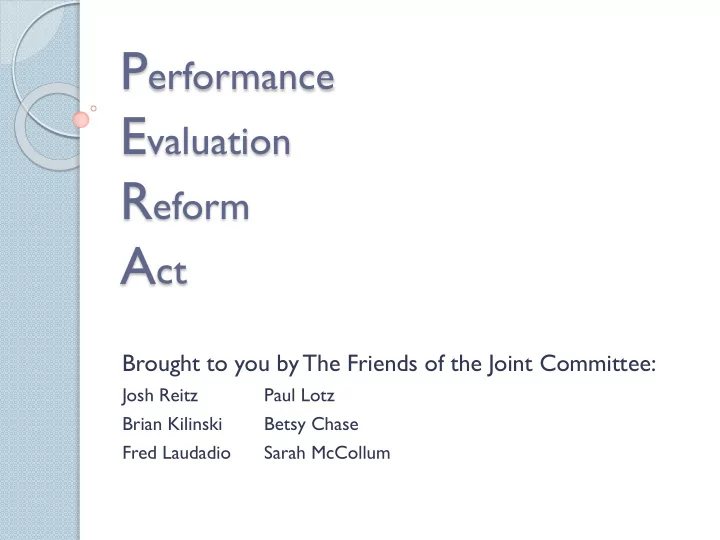

P erformance E valuation R eform A ct Brought to you by The Friends of the Joint Committee: Josh Reitz Paul Lotz Brian Kilinski Betsy Chase Fred Laudadio Sarah McCollum
Who is the Joint Committee and what do we do? An equally represented group of teachers and administrators charged with the task of bringing PERA legislation into practice in District 15 Develop and implement an evaluation plan that incorporates student growth into performance evaluations Must come to a consensus within 180 days of first official meeting
What do you know about PERA? Please take the next five minutes to talk at your table with your colleagues about what you currently know and understand about PERA
How are you feeling about PERA? What thoughts do you have about your evaluation being tied to student growth? Nervous? Indifferent? Curious? Confused? Excited?
Why we are excited! Adds objectivity to a practice that was almost universally subjective Promotes collaboration and best practices between staff and administration Provides teachers with data about their students that they can use to tailor their instruction and better meet their needs Cultivates teacher “ownership” in the evaluation process
We will need your leadership and support https://www.youtube.com/watch?v=fW8amMCVAJQ
What we are talking about with you today Description of SB7 & PERA Student Growth & Evaluations Assessments Student Learning Objectives Time Frame for Implementation
What is SB7 & PERA Senate Bill 7 ◦ Acquisition of tenure is tied to teacher evaluations ◦ RIF is based on evaluation rating groups from SB7 database ◦ Currently implemented by District 15 Performance Evaluation Reform Act ◦ Currently Danielson model represents 100% of your evaluation ◦ With PERA student growth represents a portion of your teacher evaluations At a minimum it will be 25%-30% of your evaluation The State default is 50% of your evaluation
Student Growth and Evaluations Student growth will become a significant factor in rating teacher performance evaluations PERA law defines growth as a demonstrable change in a student’s or group of students’ knowledge or skill as evidenced by gain on two or more assessments, between two or more points in time. How will we determine growth? A starting point is to choose assessments
Assessments What assessments can be used to determine student growth for PERA? Type I Assessment. ◦ Scored by non district entity and is administered either state wide or nation wide. Ex: PARCC Type 2 Assessment. ◦ District wide assessment adopted or approved by school district and used by all teachers in a specific subject area. Ex: common district-wide assessments, criterion-referenced tests, textbook assessments Type 3 Assessment. ◦ Teacher created assessments that align with course curriculum and are rigorous. Must be approved by teacher and administrator. Ex: Teacher-created assessments, performance assessments How will we measure growth thru these assessments?
Measurement Models Value-Added Adjusted Growth Simple Growth Value-Tables Student Learning Objectives
Student Learning Objectives What are Student Learning Objectives? ◦ SLO’s are a detailed process used to organize evidence of student growth over a specified period of time ◦ Benefits of SLO’s are they facilitate conversation and collaboration SLO’s increase the quality of discussions evaluators and teachers have about student learning in individual classrooms. ◦ Can be tailored to teacher goals
Time Frame for Implementation 2014/2015 School Year. ◦ Awareness and information/resource sharing. 2015/2016 School Year. ◦ Practice and Pilot. 2016-2017 School Year. ◦ Implementation of PERA.
Key Take Aways We have time to do this right, implementation is not till 16/17 school year A joint committee is in place to represent the best interests of our staff and students We will need your help and enthusiasm We are excited about the possibilities this process has
Questions?
Recommend
More recommend